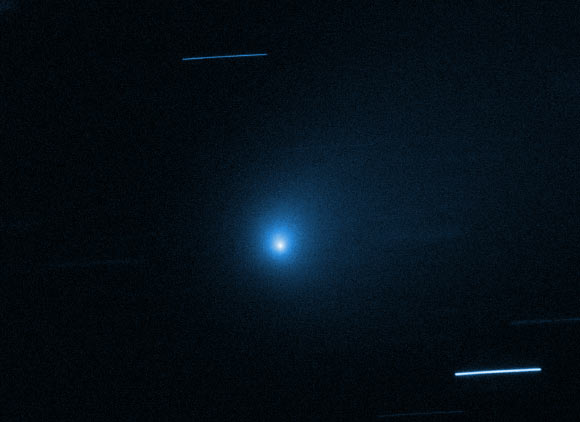Interstellar Comet 2I/Borisov Has Unusual Chemical Composition | Astronomy – Sci-News.com
Comets spend most of their lives at large distances from any star, during which time their interior compositions remain relatively unaltered. Cometary observations can provide direct insight into the chemistry that occurred during their birth at the time of planet formation. Using the NASA/ESA Hubble Space Telescope and the Atacama Large Millimeter/submillimeter Array (ALMA), two teams of astronomers have found that the gas coming out of 2I/Borisov, the first notably active interstellar comet discovered in our Solar System, contains unusually high amounts of carbon monoxide. This suggests that 2I/Borisov could have formed around a red dwarf, though other kinds of stars are possible; another idea is that the interstellar comet could be a carbon monoxide-rich fragment of a dwarf exoplanet.

Hubble captured this image of the interstellar comet 2I/Borisov on December 9, 2019. Image credit: NASA / ESA / Hubble / K. Meech, University of Hawaii / D. Jewitt, University of California, Los Angeles.
2I/Borisov was detected on August 30, 2019 by Gennady Borisov, an astronomer at the Crimean Astrophysical Observatory in Nauchnij, Ukraine, and later shown to be on a hyperbolic orbit, consistent with an interstellar origin, in the direction of Cassiopeia.
This comet is the second interstellar object discovered in the Solar System, and it showed comet-like activity since it was discovered, indicating sublimating ices. Its brightness and location in the sky made it observable for months.
This situation is very different from that of the first discovered interstellar object, ‘Oumuamua, which was much fainter, was visible for only a few weeks for most observers, and showed no detectable levels of gas or dust.
2I/Borisov’s outgassing makes it possible to probe the chemical composition of volatiles stored within the nucleus.
“With an interstellar comet passing through our own Solar System, it’s like we get a sample of a planet orbiting another star showing up in our own backyard,” said Dr. John Noonan, a researcher in the Lunar and Planetary Laboratory at the University of Arizona.
Dr. Noonan and colleagues used Hubble to look at 2I/Borisov from December 11, 2019 to January 13, 2020.
Separately, a research team led by Martin Cordiner of NASA’s Goddard Space Flight Center studied the comet on December 15 and 16, 2019, with ALMA.
The results show that 2I/Borisov’s carbon monoxide concentration is higher than that of the average solar system comet.
“Borisov’s large wealth of carbon monoxide implies that it came from a planet formation region that has very different chemical properties than the disk from which our Solar System formed,” said Dr. Dennis Bodewits, an astrophysicist at Auburn University who lead the team behind the Hubble observations.
Carbon monoxide ice is very volatile. It doesn’t take much sunlight to heat the ice and convert it to gas that escapes from a comet’s nucleus.
For carbon monoxide, this activity occurs very far from the Sun, about 17.7 billion km (11 billion miles) away, more than twice the distance of Pluto at its farthest point from the Sun. In contrast, water remains in its icy form until about 322 million km (200 million miles) from the Sun, the approximate distance of the inner edge of the asteroid belt.
However, for 2I/Borisov, the Hubble measurements suggest that some carbon monoxide ice was locked inside the comet’s nucleus, revealed only when the Sun’s heat stripped away layers of water ice.
“The amount of carbon monoxide did not drop as expected as the comet receded from the Sun. This means that we are seeing the primitive layers of the comet, which really reflect what this object is made of,” Dr. Bodewits said.
A high carbon-monoxide-to-water ratio suggests that 2I/Borisov has traveled from a very cold place — as cold as the area where Pluto is in relation to our Sun, called the Kuiper Belt.
The team theorizes 2I/Borisov may have originated around the most common type of star in the Milky Way: a red dwarf.
“These stars have exactly the low temperatures and luminosities where a comet could form with the type of composition found in 2I/Borisov,” Dr. Noonan said.
According to the astronomers behind the ALMA observations, 2I/Borisov could be a fragment of a dwarf exoplanet that had a lot of carbon monoxide near its surface, regardless of which type of star it came from.
“If that object collided with another, then the carbon monoxide-rich fragments could be released into space,” Dr. Cordiner said.
But 2I/Borisov may have simply formed as a comet with a high concentration of carbon monoxide. Alternatively, it may have an unusually thick outer layer that insulates frozen gases like hydrogen cyanide and water. As the more volatile carbon monoxide evaporates or outgases, it may appear more abundant than other cometary gases.
2I/Borisov’s unusual properties may also suggest a wider diversity of carbon monoxide in comets in our own Solar System than previously thought.
“Whatever the answer is, 2I/Borisov opens up a whole new can of worms for cometary science,” said Dr. Stefanie Milam, a researcher at NASA’s Goddard Space Flight Center.
The results were published in two papers in the journal Nature Astronomy.
_____
D. Bodewits et al. The carbon monoxide-rich interstellar comet 2I/Borisov. Nat Astron, published online April 20, 2020; doi: 10.1038/s41550-020-1095-2
M.A. Cordiner et al. Unusually high CO abundance of the first active interstellar comet. Nat Astron, published online April 20, 2020; doi: 10.1038/s41550-020-1087-2





